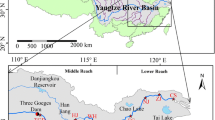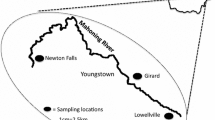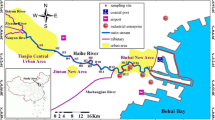Abstract
The concentration characteristics, sources, and potential ecological risk assessment of 16 PAHs were investigated in the surface water from the Songhua River Basin, Northeast China. A total of 48 river water samples, including 16 from the main streams and 32 from the tributaries, were collected. Samples were separated into dissolved phases and suspended particle matter (SPM) via filtration with 0.47 μm glass fiber filters. Each phase was analyzed for PAHs. The total PAH concentration in the dissolved phase in the water ranged from 32.5 to 108 ng L−1 and from 0.3 to 62.3 μg g−1 (dry weight) in the suspended particle matter (SPM). The total PAH concentration in the main stream was lower than in the tributaries; the volume of annual runoff of rivers had a significant effect on the ƩPAH in the rivers. The 2- and 3-ring PAHs dominated in both the dissolved phase and SPM, indicating a relatively recent local source of PAHs in the study area. The concentrations of PAHs in the Songhua River Basin are lower when compared with the values previously reported in the literature from other rivers around the world. The sources of PAHs were assessed by diagnostic ratios and principal component analysis (PCA), and the ecological risk of the PAHs was assessed based on the risk quotient (RQ). The diagnostic ratios and PCA indicated that the main sources of PAHs originated from pyrogenic and petrogenic sources, and pyrogenic sources had a greater impact. The ecological risk assessment indicated that the PAHs presented low ecosystem risk in the Songhua River Basin.





Similar content being viewed by others
References
Bispo JRL, Navickiene S, Dórea HS (2011) Method validation for SPE applied to determination of PAH in petroliferous industry effluent water. Am J Anal Chem 2(08):971
Cao Z, Liu J, Luan Y et al (2010) Distribution and ecosystem risk assessment of polycyclic aromatic hydrocarbons in the Luan River, China. Ecotoxicology 19:827–837
Chen B, Xuan X, Zhu L et al (2004) Distributions of polycyclic aromatic hydrocarbons in surface waters, sediments and soils of Hangzhou City, China. Water Res 38:3558–3568
Cui S, Fu Q, Guo L et al (2016) Spatial temporal variation, possible source and ecological risk of PCBs in sediments from Songhua River, China: effects of PCB elimination policy and reverse management framework. Marin. Pollut Bullet 106:109–118
Dachs J, Glenn TR, Gigliotti CL et al (2002) Processes driving the short-term variability of polycyclic aromatic hydrocarbons in the Baltimore and northern Chesapeake Bay atmosphere, USA. Atmos Environ 36:2281–2295
Dickhut RM, Canuel EA, Gustafson KE (2000) Automotive sources of carcinogenic polycyclic aromatic hydrocarbons associated with particulate matter in the Chesapeake Bay region. Environ Sci and Tech 34:4635–4640
Doong RA, Lin YT (2004) Characterization and distribution of polycyclic aromatic hydrocarbon contaminations in surface sediment and water from Gao-** River, Taiwan. Water Res 38:1733–1744
Dushyant R, Dudhagara RK, Rajpara JK et al (2016) Distribution, sources and ecological risk assessment of PAHs in historically contaminated surface sediments at Bhavnagar coast, Gujarat, India. Environ Pollut 213:338–346
Eremina N, Paschke A, Mazlona EA et al (2016) Distribution of polychlorinated biphenyls, phthalic acid esters, polycyclic aromatic hydrocarbons and organochlorine substances in the Moscow River, Russia. Environ Pollut 210:409–418
Fajgelj A, & Ambrus Á (2000). Guidelines for single-laboratory validation of analytical methods for trace-level concentrations of organic chemicals. In principles and practices of method validation (pp. 179-252).
Fernandes MB, Sicre MA, Boireau A et al (1997) Polyaromatic hydrocarbon (PAH) distributions in the Seine River and its estuary. Mar Pollut Bull 34:857–867
Guo W, He M, Yang Z et al (2011) Aliphatic and polycyclic aromatic hydrocarbons in the **he River, an urban river in China’s Shenyang City: distribution and risk assessment. J Hazard Mater 186:1193–1199
Harrison RM, Smith DJT, Luhana L et al (1996) Source apportionment of atmospheric polycyclic aromatic hydrocarbons collected from an urban laocation in BIrmingham, UK. Environ Sci and Tech 30:825–832
Ho KF, Lee SC, Chiu GMY et al (2002) Characterization of selected volatile organic compounds, polycyclic aromatic hydrocarbons and carbonyl compounds at a roadside monitoring station. Atmosp Environ 36:57–65
Hu J, Liu CQ, Zhang GP et al (2014) Distribution characteristic and sources apportionment of polycyclic aromatic hydrocarbons (PAHs) in Liao River drainage basin, Northeast China. Environ Monit Assessm 188:227–238
Johnsen AR, Wick LY, Harms H et al (2005) Principles of microbial PAH-degradation in soil. Environ Pollut 133:71–84
Kalf DF, Crommentuijn T, Plassche EJ et al (1997) Environment quality objectives for 10 polycyclic aromatic hydrocarbons (PAHs). Ecotoxicol Environ Saf 36:89–97
Keith LH, Telliard WA (1979) Priority pollutants. Environ Sci and Tech 13:416–424
Khalili NR, Scheff PA, Holsen TM et al (1995) PAH source fingerprints for coke ovens, diesel and, gasoline engines, highway tunnels, and wood combustion emissions. Atmosp Environ 29:533–542
Li GX, Yang XH, Wang ZF et al (2006) Distribution and sources of polycyclic aromatic hydrocarbons in the middle and lower reaches of the Yellow River, China. Environ Pollut 14:985–993
Li YL, Liu JL, Cao ZG et al (2010) Spatial distribution and health risk of heavy metals and polycyclic aromatic hydrocarbons (PAHs) in the water of the Luanhe River Basin, China. Environ Monit Assess 163:1–13
Liu J-R, Pang Y-X, Tang X-L, Dong H-W, Chen B-Q, Sun C-H (2007) Genotoxic activity of organic contamination of the Songhua River in the north-eastern region of the People’s Republic of China. Mutat Res Genet Toxicol Environ Mutagen 634(1–2):81–92
Liu RP, Liu HJ, Wan DJ et al (2014) Distribution and transportation of polycyclic aromatic hydrocarbons (PAHs) at the Humen river mouth in the Pearl River delta and their influencing factors. Marin. Pollut Bullet 84:401–410
Mai BX, Fu JM, Sheng GY et al (2002) Chlorinated and polycyclic aromatic hydrocarbons in riverine and estuarine sediments from Pearl River Delta, China. Environ Pollut 117:457–474
Malik A, Priyanka V, Arun KS et al (2011) Distribution of polycyclic aromatic hydrocarbons in water and bed sediments of the Gomti River, India. Environ Monit Assess 172:529–545
Ministry of Environmental Protection of the People’s Republic of China, 2015. 20014 Report on the State of the Environment of China
Nagy AS, Simon G, Szabó J, Vass I et al (2013) Polycyclic aromatic hydrocarbons in surface water and bed sediments of the Hungarian upper section of the Danube River. Environ Monit Assess 185:4619–4631
Okoli CP, Adewuyi GO, Zhang Q et al (2015) Aqueous scavenging of polycyclic aromatic hydrocarbons using epichlorohydrin, 1,6-hexamethylene diisocyanate and 4,4-methylene diphenyl diisocyanate modified starch: pollution remediation approach. Arab J Chem. doi:10.1016/j.arabjc.2015.06.004
Okoli CP, Adewuyi GO, Zhang Q, Guo Q (2016) QSAR aided design and development of biopolymer-based SPE phase for liquid chromatographic analysis of polycyclic aromatic hydrocarbons in environmental water samples. RSC Adv 6(75):71596–71611
Parinos C, Gogou A (2016) Suspended particle-associated PAHs in the open eastern Mediterranean Sea: occurrence, sources and processes affecting their distribution patterns. Marine Chem 180:42–50
Patrolecco L, Ademollo N, Capri S et al (2010) Occurrence of priority hazardous PAHs in water, suspended particulate matter, sediment and common eels (Anguilla anguilla) in the urban stretch of the River Tiber (Italy). Chemosphere 81:1386–1392
** LF, Luo YM, Zhan HB et al (2007) Distribution of polycyclic aromatic hydrocarbons in thirty typical soil profiles in the Yangtze River Delta region, east China. Environ Pollut 147:358–365
Sarria-Villa R, Ocampo-Duque M, Páez M et al (2016) Presence of PAHs in water and sediments of the Colombian Cauca River during heavy rain episodes, and implications for risk assessment. Sci Total Environ 540:455–465
Shi Z, Tao S, Pan B et al (2005) Contamination of rivers in Tian**, China by polycyclic aromatic hydrocarbons. Environ Pollu 134:97–111
Simcik MF, Eisenreich SJ, Lioy PJ (1999) Source apportionment and source/sink relationships of PAHs in the coastal atmosphere of Chicago and Lake Michigan. Atmos Environ 33:5071–5079
Singh KP, Malik A, Mohan D et al (2004) Multivariate statistical techniques for the evaluation of spatial and temporal variations in water quality of Gomti River (India)—a case study. Water Res 38:3980–3992
Song XY, Hu XJ, He MM et al (2013) Distribution and sources of polycyclic aromatic hydrocarbons in the surface water of Taizi River, Northeast of China. Environ Monit Assess 185:8375–8382
Song XY, Song SB, Sun WY et al (2015) Recent changes in extreme precipitation and drought over the Songhua River Basin, China, during 1960-2013. Atmos Res 157:137–152
Sun SC, **ao WH, Zhou ZH et al (2011) Impact of the second branch Yinma River on water quality of Songhua River based on mathematical model. Water resources protection 27:7–12
Voulvoulis N, Liu JR, Pang YX et al (2007) Genotoxic activity of organic contamination of the Songhua River in the north-eastern region of the People’s Republic of China. Mutat Res 634:81–92
Wang XC, Zhang YX, Chen RF et al (2001) Distribution and partitioning of polycyclic aromatic hydrocarbons (PAHs) in different size fractions in sediments from Boston Harbor, United States. Marin Pollut Bullet 42:1139–1149
Wang C, Feng YJ, Zhao SS et al (2012) Dynamic contaminant fate model of organic compound: a case study of nitrobenzene pollution in Songhua River, China. Chemosphere 88:69–76
Wang Y, Wang P, Bai YJ et al (2013) Assessment of surface water quality via multivariate statistical techniques: a case study of the Songhua River Harbin region, China. J Hydro-environ Res 7:30–40
Wang M, Wang CY, Hu XK et al (2015a) Distributions and sources of petroleum, aliphatic hydrocarbons and polycyclic aromatic hydrocarbons (PAHs) in surface sediments from Bohai Bay and its adjacent river, China. Marin Pollut Bullet 90:88–94
Wang SJ, Wang YJ, Ran LS et al (2015b) Climatic and anthropogenic impacts on runoff changes in the Songhua River basin over the last 56 years (1955–2010), Northeastern China. Catena 127:258–269
Wang XZ, Liu ZM, Wang C et al (2016) Occurrence and formation potential of nitrosamines in river water and ground water along the Songhua River, China. J Environ Sci 50:65–71
Wu B, Zhang R, Chen SP et al (2011a) Risk assessment of polycyclic aromatic hydrocarbons in aquatic ecosystems. Ecotoxicology 20:1124–1130
Wu B, Zhang Y, Zhang XX et al (2011b) Health risk assessment of polycyclic aromatic hydrocarbons in the source water and drinking water of China: quantitative analysis based on published monitoring data. Sci Total Environ 410-411:112–118
Xu J, Guo JY, Liu GR et al (2014) Historical trends of concentrations, source contributions and toxicities for PAHs in dated sediment cores from five lakes in western China. Sci Total Environ 470-471:519–526
Yim UH, Hong SH, Shim WJ et al (2005) Spatio-temporal distribution and characteristics of PAHs in sediments from Masan Bay, Korea. Mar. Pollut Bull 50:319–326
Yu W, Liu R, Xu F et al (2016) Identifications and seasonal variations of sources of polycyclic aromatic hydrocarbons (PAHs) in the Yangtze River Estuary, China. Marine Pollut Bullet 104:347–354
Yunker MB, Macdonald RW, Vingarzan R et al (2002) PAHs in the Fraser River basin: a critical appraisal of PAH ratios as indicators of PAH source and composition. Organic Geochem 33:489–515
Zhang Y, Tao S (2008) Seasonal variation of polycyclic aromatic hydrocarbons (PAHs) emissions in China. Environ Pollut 156:657–663
Zhang SY, Zhang Q, Darisaw S et al (2007) Simultaneous quantification of polycyclic aromatic hydrocarbons (PAHs), polychlorinated biphenyls (PCBs), and pharmaceuticals and personal care products (PPCPs) in Mississippi river water, in New Orleans, Louisiana, USA. Chemosphere 66:1057–1069
Zheng BH, Wang LP, Lei K et al (2016) Distribution and ecological risk assessment of polycyclic aromatic hydrocarbons in water, suspended particulate matter and sediment from Daliao River estuary and the adjacent area, China. Chemosphere 149:91–100
Zhu LZ, Chen BL, Wang J et al (2004) Pollution survey of polycyclic aromatic hydrocarbons in surface water of Hangzhou, China. Chemosphere 56:1085–1095
Acknowledgements
This work was supported by the National Grand Science and Technology Special of China (no. 2012ZX07503003-001), the National Natural Science Foundation of China (nos. 40703021, 41625006, and 41250110528), the Chinese Academy of Sciences (nos. KZCX2EW102 and XDB15020401), the Sino-German Center (no. GZ1055), and the Feature Institute Program of the Chinese Academy of Sciences (Comprehensive Technical Scheme and Integrated Demonstration for Remediation of Soil and Groundwater in Typical Area). We also would like to appreciate Professor Bixian Mai’s team at the Guangzhou Institute of Geochemistry, CAS for their help with the laboratory analysis of PAHs.
Author information
Authors and Affiliations
Corresponding authors
Additional information
Responsible editor: Ester Heath
Rights and permissions
About this article
Cite this article
Hu, J., Liu, C., Guo, Q. et al. Characteristics, source, and potential ecological risk assessment of polycyclic aromatic hydrocarbons (PAHs) in the Songhua River Basin, Northeast China. Environ Sci Pollut Res 24, 17090–17102 (2017). https://doi.org/10.1007/s11356-017-9057-7
Received:
Accepted:
Published:
Issue Date:
DOI: https://doi.org/10.1007/s11356-017-9057-7




